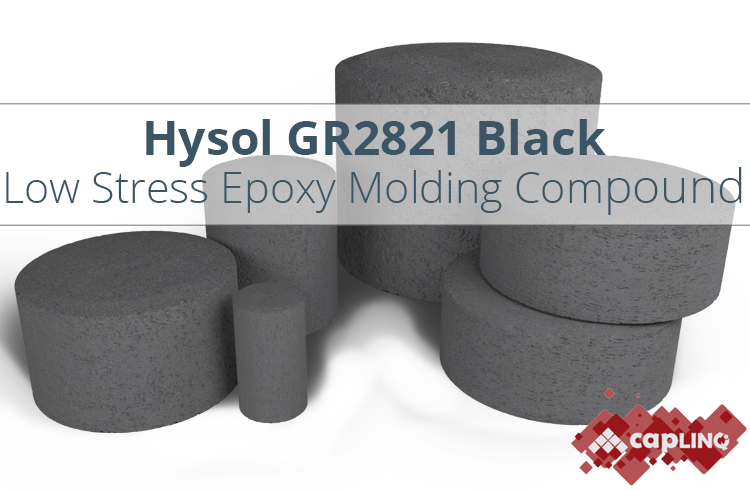Hysol GR2821 | Black Epoxy Mold Compound
- Completely Superseded by GR2820
- Ultra-low stress epoxy mold compound
- Thin Wall Crack Resistance
Product Description
***GR2821 has been completely superseded by GR2820***
Did you come looking for GR2821? This product is no longer available and has been completely superseded by GR2820.
Wait, so 21 superseded by 20? Yes, naming conventions were not that bright back then.
Hysol GR2821 was a black semiconductor-grade epoxy molding compound or duroplast designed for the encapsulation and protection of thin walled conductive polymer tantalum solid capacitors (POSCAP). Once molded and post-mold cured, this product provided optimum protection and reliability for these capacitor devices. It had been designed for Conductive Polymer Tantalum Solid Capacitors (POSCAP) In the world of passive components, POSCAPs were relatively new to the scene. These solid electrolytic capacitors have many advantages, but offer challenges for epoxy mold compound manufacturers. After many years of development, the GR2821 has been developed to have excellent thin wall crack resistance - the greatest challenge of molding these devices. Furthermore, it has been optimized for automolding equipment.
Hysol GR2821 was an environmentally "green" product, meaning that didn't contain any bromine, antimony or phosphorus flame retardants. Previous MG-series EMC dominated the space for tantalum capacitors but used halogen-containing flame retardants. This next generation epoxy mold compound replaces these older generation products. This material was designed to achieve JEDEC Level 1 requirements at 260°C reflow temperature on conductive polymer capacitors. It's fast cure time also ensures that it is compatible with the latest automold manufacturing equipment. Hysol GR2821 meets UL 94 V-0 Flammability at 1/4 inch (6.35mm) thickness.
Technical Specifications
| General Properties | |
| Color Color The color | Black |
| Filler Content | 85 % |
| Specific Gravity Specific Gravity Specific gravity (SG) is the ratio of the density of a substance to the density of a reference substance; equivalently, it is the ratio of the mass of a substance to the mass of a reference substance for the same given volume. For liquids, the reference substance is almost always water (1), while for gases, it is air (1.18) at room temperature. Specific gravity is unitless. | 1.96 |
| Electrical Properties | |
| Volume Resistivity Volume Resistivity Volume resistivity, also called volume resistance, bulk resistance or bulk resistivity is a thickness dependent measurement of the resistivity of a material perpendicular to the plane of the surface. | 1.0x1016 Ohms⋅cm |
| Chemical Properties | |
| Moisture absorption | 0.35 % |
| Physical Properties | |
| Spiral Flow @ 175°C | 101.6 cm |
| Thermal Properties | |
| Glass Transition Temperature (Tg) Glass Transition Temperature (Tg) The glass transition temperature for organic adhesives is a temperature region where the polymers change from glassy and brittle to soft and rubbery. Increasing the temperature further continues the softening process as the viscosity drops too. Temperatures between the glass transition temperature and below the decomposition point of the adhesive are the best region for bonding. The glass-transition temperature Tg of a material characterizes the range of temperatures over which this glass transition occurs. | 116 °C |
| Thermal Conductivity Thermal Conductivity Thermal conductivity describes the ability of a material to conduct heat. It is required by power packages in order to dissipate heat and maintain stable electrical performance. Thermal conductivity units are [W/(m K)] in the SI system and [Btu/(hr ft °F)] in the Imperial system. | 2.7 W/m.K |
| UL 94 Rating UL 94 Rating Flammability rating classification. It determines how fast a material burns or extinguishes once it is ignited. HB: slow burning on a horizontal specimen; burning rate less than 76 mm/min for thickness less than 3 mm or burning stops before 100 mm V-2: burning stops within 30 seconds on a vertical specimen; drips of flaming particles are allowed. V-1: burning stops within 30 seconds on a vertical specimen; drips of particles allowed as long as they are not inflamed. V-0: burning stops within 10 seconds on a vertical specimen; drips of particles allowed as long as they are not inflamed. 5VB: burning stops within 60 seconds on a vertical specimen; no drips allowed; plaque specimens may develop a hole. 5VA: burning stops within 60 seconds on a vertical specimen; no drips allowed; plaque specimens may not develop a hole | V0 |
| Mechanical Properties | |
| Molded Shrinkage | 0.1 % |
| Curing Conditions | |
| Transfer Pressure | 40 - 85 kg/cm2 |
| Transfer Time | 5 - 15 s |




